Multi-objective Bayesian optimization for the retrieval of aggregated aerosol structures from microscopic images
IF 2.9
3区 环境科学与生态学
Q2 ENGINEERING, CHEMICAL
引用次数: 0
Abstract
Aerosol particles are increasingly recognized for their significant impacts on human health and climate. Often found in aggregated form, the morphology of these particles plays a crucial role in influencing their physicochemical properties. Owing to the sub-micron size, electron microscopy is the most commonly used technique to visualize the aggregated particles. In a prior study, we proposed a combination of forward modelling coupled with optimization techniques for the prediction of 3-dimensional structures from microscopic images. Here, we extend the methodology to a multi-objective optimization approach for the specific cases where aggregated particles are classified and sampled based on specific properties such as mobility diameter, aerodynamic diameter etc. The comparison of 2-dimensional features of the microscopic image with the projections of computationally generated aggregates forms the first objective function, while the comparison of the measured 3-dimensional property, mobility diameter, is used as the second objective function. The estimation of the mobility diameter often requires the calculation of the hydrodynamic radius (Rh) and the orientationally averaged projected area (PA), which can be computationally expensive for larger aggregates and for frequent calculations. Bayesian optimization is used for the retrieval process, as it can provide much faster convergence with significantly fewer function evaluations compared to metaheuristic algorithms. The multi-objective Bayesian optimization-based retrieval algorithm has been validated using synthetically generated and experimentally collected microscopic images. The process is found to be about 5–10 times faster than previously reported methods. The algorithm is further extended to retrieve aggregates with polydisperse and overlapping monomers. The retrieval process demonstrated strong accuracy, with fractal parameters showing around 10–15% error compared to the original values. This includes a mobility diameter difference of less than 10%, indicating high similarity between retrieved and input structures. Furthermore, tests are conducted on welding fume particles of varying mobility diameters, where retrieved structures consistently exhibited mobility diameters within a 10% difference from original values.
多目标贝叶斯优化从显微图像中检索聚集气溶胶结构
人们越来越认识到气溶胶粒子对人类健康和气候的重大影响。通常以聚集形式存在,这些颗粒的形态在影响其物理化学性质方面起着至关重要的作用。由于亚微米的尺寸,电子显微镜是最常用的技术来可视化聚集的颗粒。在之前的一项研究中,我们提出了将正演建模与优化技术相结合的方法,用于从微观图像中预测三维结构。在这里,我们将该方法扩展为针对特定情况的多目标优化方法,其中聚集颗粒根据特定属性(如迁移直径,气动直径等)进行分类和采样。微观图像的二维特征与计算生成的聚集体的投影的比较形成了第一个目标函数,而测量的三维特性,迁移直径的比较被用作第二个目标函数。迁移直径的估计通常需要计算流体动力半径(Rh)和取向平均投影面积(PA),这对于较大的集料和频繁的计算来说可能是计算昂贵的。贝叶斯优化用于检索过程,因为与元启发式算法相比,它可以提供更快的收敛速度和更少的函数计算。基于贝叶斯优化的多目标检索算法通过综合生成和实验采集的显微图像进行了验证。该过程比以前报道的方法快5-10倍。该算法进一步扩展到检索具有多分散和重叠单体的聚集体。结果表明,分形参数与原始值相比误差在10-15%左右。这包括小于10%的迁移率直径差异,表明检索结构和输入结构之间的高度相似性。此外,对不同迁移率直径的焊接烟尘颗粒进行了测试,其中检索到的结构始终显示迁移率直径与原始值相差10%。
本文章由计算机程序翻译,如有差异,请以英文原文为准。
求助全文
约1分钟内获得全文
求助全文
来源期刊

Journal of Aerosol Science
环境科学-工程:化工
CiteScore
8.80
自引率
8.90%
发文量
127
审稿时长
35 days
期刊介绍:
Founded in 1970, the Journal of Aerosol Science considers itself the prime vehicle for the publication of original work as well as reviews related to fundamental and applied aerosol research, as well as aerosol instrumentation. Its content is directed at scientists working in engineering disciplines, as well as physics, chemistry, and environmental sciences.
The editors welcome submissions of papers describing recent experimental, numerical, and theoretical research related to the following topics:
1. Fundamental Aerosol Science.
2. Applied Aerosol Science.
3. Instrumentation & Measurement Methods.
 求助内容:
求助内容: 应助结果提醒方式:
应助结果提醒方式:


